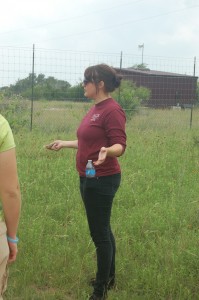As previously mentioned, the UIndy team had the opportunity to visit the Forensic Anthropology Center at Texas State University (FACTS). The majority of the unidentified migrants from Brooks County go to Texas State University to continue the identification process. The massive endeavor, called Operation Identification, is coordinated by Dr. Kate Spradley. Unfortunately Dr. Spradley was not in town on the day of our visit, but we did get to spend time with Dr. Danny Wescott, director of FACTS.

Hailey Duecker, the graduate student assistant for Operation Identification, took the UIndy team and those Baylor students that wanted to see the facility on a tour. We began by seeing the Forensic Anthropology Research Facility (FARF). The FARF is a 26 acre outdoor human decomposition research laboratory that also serves as a reservoir for the unidentified individuals as they await processing and analysis. Hailey showed us the donated bodies that are used to study various aspects of the decomposition process, as well as the area of the FARF dedicated to Operation Identification. Being a native Texan I had been to San Marcos before (mostly to tube in the river) but I was still shocked by the temperature. The sun felt just as hot as it had in Falfurrias. It will be interesting to see if the research coming out of the FARF can assist with time since death (postmortem interval or PMI) estimates for the individuals discovered on the ranches in Brooks County. Any additional information about these individuals could potentially help with the identification process.
 Next, Hailey took us on a tour of the Osteological Research and Processing Laboratory (ORPL) located at the Freeman Ranch Multi-Purpose Facility. At ORPL the remains are processed by volunteers. Once the skeletons are clean, they are analyzed and a biological profile (reconstruction of the decedent’s living characteristics) is constructed by the forensic Anthropologists at FACTS. In addition, samples are taken for DNA and isotope analysis. Associated personal effects are cleaned, cataloged and stored as these can be important clues to the identity of the individuals carrying them. Finally, the unidentified are prepared for curation until an identification is made and repatriation can be conducted.
Next, Hailey took us on a tour of the Osteological Research and Processing Laboratory (ORPL) located at the Freeman Ranch Multi-Purpose Facility. At ORPL the remains are processed by volunteers. Once the skeletons are clean, they are analyzed and a biological profile (reconstruction of the decedent’s living characteristics) is constructed by the forensic Anthropologists at FACTS. In addition, samples are taken for DNA and isotope analysis. Associated personal effects are cleaned, cataloged and stored as these can be important clues to the identity of the individuals carrying them. Finally, the unidentified are prepared for curation until an identification is made and repatriation can be conducted.
Texas State University, like the other educational institutions participating in the identification of the undocumented migrants, rely on volunteers (qualified faculty and students), as well as donations to participate in this mission. The processing of one individual can take several weeks and as a result they have been working around the clock on the individuals exhumed last year and still have a backlog. Add a portion of the individuals exhumed this summer and they are in need of support. Last summer Ryan spent several weeks at FACTS volunteering to process after we returned from the field. We are encouraging the Baylor students as well as other qualified students that have had osteology to volunteer in this effort. Additionally, the center could use monetary donations and donations of PPE (personal protective equipment). The exhumations conducted by the University of Indianapolis and Baylor University are just the first part of the journay towards identification.
~KEL